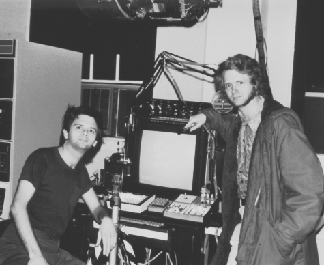
Mike Pique and Jim Lipscomb with the PDP-11 minicomputer and Vector General line-drawing display in November 1976. (Photo: Mike Pique, © Department of Computer Science, UNC-Chapel Hill) |
Faculty ExpansionBy 1982, well into Fred's fourth five-year term as chairman, he made it clear that he was ready to be relieved. We received permission to look outside the Department for a suitable replacement, and spent two years looking unsuccessfully. Fred did obtain a leave from the chairmanship during the last half of 1982, with Don Stanat serving as acting chairman. In March 1983, Don and Henry Fuchs began to represent us on a search committee for the new chairman. The committee worked into 1984, and the position was offered to Charles Molnar of Washington University (St. Louis). After some thought, Molnar declined the appointment, and we had to start over.
|
|
On a one-year visit from IBM in 1982-83, Bernie Witt became our second full-
time research faculty member. Longer-term additions were Dean Brock and
Kye Hedlund. Dean (his name, not a title, occasionally an amusing source of
confusion) came from M.I.T., where he had specialized in operating systems
and computer networking. Kye came from Purdue with a particular interest
in very large-scale integration (VLSI) of microelectronic circuitry. Kye is
still with us. Dan Reed joined the faculty for 1983-84; he had really wanted to go to the University of Illinois, which had no positions available in 1983. A position opened up the following year; Dan moved there and stayed. Turner Whitted, a computer graphics expert widely known for ray tracing, joined the faculty part-time in 1983-84. He has continued with us to the present. Fred's last term as chairman ended on 30 June 1984, after exactly 20 years. Don Stanat filled in again, this time for the entire 1984-85 academic year. In that same year, John Halton and Dave Plaisted, from the Universities of Wisconsin and Illinois, respectively, joined as full professors. John applies combinatorial and probabilistic methods to computational problems. Dave specializes in term-rewriting systems and mechanical theorem proving. John Smith, who had earned an Ph.D. in English under Sally Sedelow in 1970, returned to UNC-CH from Penn. State and joined us as associate professor. His early work in text and natural language processing had expanded to include human-computer interaction, hypermedia systems, and computer- supported cooperative work (CSCW). All three colleagues are still with us. Dave Beard came as assistant professor. He moved to Radiology after four years, but continues to hold an adjunct appointment with us. Dan Hoffman, our own Ph.D. graduate, accepted a one-year appointment. Our activity in microelectronics grew to the point that the May 1985 major annual design conference, whose venue had alternated between the prestigious laboratories of Caltech and M.I.T., was held under our auspices in Chapel Hill. The chairman search committee had returned to work, and we got our second chairman in July 1985. Jay Nievergelt had been a professor at Illinois and at the Eidgenossische Technische Hochschule in Zurich. He came as William Rand Kenan, Jr., professor and chairman. Jay was particularly interested in algorithms for geometric computation; he brought his recent Ph.D. graduate Klaus Hinrichs as a visitor for two years. In 1986-87 we were joined by James Coggins and Yuki Watanabe. After graduation from Michigan State (where Carl Page was on his committee), James had served as assistant professor at Worcester Polytechnic. His research is in computer vision and image processing. He has remained with us and now serves as Associate Chairman for Academics. Yuki's Ph.D. was from the University of Rochester; he came to us from Bell Labs. He was interested in VLSI design and in fuzzy logic, and remained until 1993. This period also saw the beginning of a series of major federal awards that supported infrastructure development. The first was a $3.1M 1983-88 grant from the National Science Foundation (NSF) for a Center for Experimental Research in Computer Science. A companion award went to Duke, with whom we had submitted a joint proposal. The second was a $4.6M 1986-91 contract with the Office of Naval Research for Infrastructure of Command Information Systems, which helped to build our research capability in distributed computer systems. The third was a $2.5M 1988-93 grant from NSF under the Institutional Infrastructure Program. The fourth is a 1991-96 grant from NSF and the Defense Advanced Research Projects Agency, shared equally with Brown, Caltech, Cornell, and Utah, for a Science and Technology Center for Computer Graphics and Scientific Visualization. Our share of the monetary award is budgeted at $2.4M, and is being supplemented by some $0.8M in equipment contributions from manufacturers. Another significant development was the establishment of the Microelectronic Systems Laboratory (MSL). Its mission was to support both the Department and the state's microelectronics community with a capability for performing all aspects of microelectronic systems design and construction other than chip manufacture. Next Section: "Staff: Administrative and Technical"
|